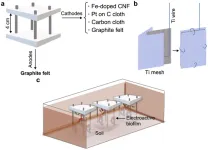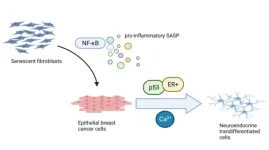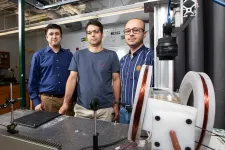(Press-News.org)
In the context of increasing energy demands and environmental concerns, renewable energy solutions are crucial for achieving net-zero emissions by 2050. Microbial electrochemical technologies, such as SMFCs, are cost-effective and environmentally friendly, making them an attractive option for green energy systems. SMFCs utilize endogenous microorganisms present in soil to convert organic matter into electricity, offering a sustainable energy source and a self-powered in situ bioremediation strategy for contaminated soils.
Cathode materials play a significant role in the performance of microbial fuel cells. In this study, researchers compared the performance of membrane-free air-cathode SMFCs using four different cathodes: carbon cloth, Pt-doped carbon cloth, graphite felt, and an innovative Fe-doped carbon nanofibers electrode. The researchers conducted electrochemical tests over extended periods, along with microbial taxonomic analyses, to assess the effect of electrode materials on biofilm formation and electrochemical performance.
In a study published in Volume 16 of the journal Environmental Science and Ecotechnology on April 2023, researchers from University of Bath revealed that Fe-doped carbon nanofibers and Pt-doped carbon cloth cathodes yielded stable performances, with peak power densities of 25.5 and 30.4 mW m−2, respectively. Graphite felt cathodes demonstrated the best electrochemical performance, with a peak power density of 87.3 mW m−2. However, they also exhibited the greatest instability.
An examination of microbial communities found differences between anodic and cathodic communities. Anodes were predominantly enriched with Geobacter and Pseudomonas species, while cathodic communities were dominated by hydrogen-producing and hydrogenotrophic bacteria. This suggests that hydrogen cycling could be a possible electron transfer mechanism. Additionally, the presence of nitrate-reducing bacteria in combination with cyclic voltammogram results indicated that microbial nitrate reduction occurred on graphite felt cathodes.
The use of innovative Fe-doped carbon nanofiber cathodes provided an electrochemical performance comparable to Pt-doped carbon cloth, offering a low-cost alternative. However, graphite felt outperformed all other electrodes tested but displayed lower reproducibility and higher mass transport losses. Microbial taxonomic profiling of the cathode biofilms revealed the presence of taxa related to oxygen reduction or involvement in utilizing alternative electron acceptors, such as nitrate.
The results of this study can guide future research on low-cost, high-performing SMFCs for practical applications in energy harvesting and bioremediation. By understanding how electrode materials influence microbial communities and electrochemical performance, researchers can accelerate the translation of SMFCs into real-world implementations.
###
References
Authors
Arpita Nandy a, Daniel Farkas b, Belén Pepió-Tárrega c, Sandra Martinez-Crespiera c, Eduard Borràs c, Claudio Avignone-Rossa b, Mirella Di Lorenzo a
Affiliations
a Department of Chemical Engineering and Centre for Biosensors, Bioelectronics & Biodevices (C3Bio), University of Bath, Claverton Down, BA2 7AY, UK
b Department of Microbial Sciences, University of Surrey, Guildford, GU2 7XH, UK
c LEITAT Technological Center, C/ de la Innovació, 2, 08225, Terrassa, Barcelona, Spain
END
Ruminants like cows have developed an unusual way of digesting their food: they ingest plants, give them a rough chewing and then swallow the half-chewed mash before regurgitating it repeatedly and continuing to chew. This has clear advantages, as a research team including the University of Göttingen has shown: the regurgitated mushy food contains much less hard grit, sand and dust than the food that they first ingested. This protects the teeth from being ground down during the chewing process. This ...
“We recently unveiled a new interesting role for SASP: its ability to induce neuroendocrine transdifferentiation (NED) in breast cancer epithelial cells [3].”
BUFFALO, NY- May 12, 2023 – A new editorial paper was published in Aging (listed by MEDLINE/PubMed as "Aging (Albany NY)" and "Aging-US" by Web of Science) Volume 15, Issue 8, entitled, “The senescence-associated secretory phenotype induces neuroendocrine transdifferentiation.”
In this editorial, researchers Anda Huna, Nadine Martin and David Bernard from the Université de Lyon discuss the senescence-associated secretory phenotype (SASP). SASP, ...
Larry Steckel, row crop weed specialist and professor in the Department of Plant Sciences at the University of Tennessee Institute of Agriculture, has been named a Fellow of the Southern Weed Science Society (SWSS).
The award was given to honor Steckel’s years of research and contributions to weed prevention in row crop agriculture. Steckel was among only a small group of esteemed researchers to receive the honor, presented to him during the annual meeting of the SWSS.
Steckel says he is proud to be named a Fellow, and that he knows the research and extension work conducted by weed specialists across the ...
Manufacturing and metrology considerations are key when designing with freeform optics
Close communication between optics designers and manufacturers can help prevent problems
Québec City, Canada -- Although optical components such as lenses are traditionally spherical in shape, freeform optical components, which have little to no symmetry around the optical axis, are becoming more common. Freeform optical components are attractive because they can be designed to behave in ways traditional optics cannot, offering optical design flexibility ...
A team of scientists from the Department of Energy’s Ames National Laboratory have developed a way to collect terahertz imaging data on materials under extreme magnetic and cryogenic conditions. They accomplished their work with a new scanning probe microscope. This microscope was recently developed at Ames Lab. The team used the ultralow temperature terahertz microscope to take measurements on superconductors and topological semimetals. These materials were were exposed to high magnetic fields and temperatures below liquid helium (below 4.2 ...
A new study led by physicist Sascha Kempf at the University of Colorado Boulder has delivered the strongest evidence yet that Saturn’s rings are remarkably young—potentially answering a question that has boggled scientists for well over a century.
The research, to be published May 12 in the journal Science Advances, pegs the age of Saturn’s rings at no more than 400 million years old. That makes the rings much younger than Saturn itself, which is about 4.5 billion years old.
“In ...
FOR IMMEDIATE RELEASE, May 12, 2023
Contact: Gina DiGravio, 617-358-7838, ginad@bu.edu
Researchers Identify a Brain Marker Indicating Future Suicide Risk
Changing the connectivity in this brain circuit with stimulation or pharmacotherapies could represent new treatments to reduce suicide risk.
(Boston)—Identifying people at high risk for suicide is critical for applying lifesaving interventions and treatments. However, it is very difficult to identify who is at greatest risk and only modest improvements has been made in identifying high risk people over the last 50 years. One novel way to identify people at high risk of suicide is by investigating and identifying brain markers.
VA ...
The spiral-shaped bacteria Helicobacter pylori are common and troublesome.
More than 13 percent of Americans have an H. pylori infection, although rates vary with age, race and socioeconomic status. The microorganism uses its corkscrew-like tail to power forward through viscous fluids such as stomach mucus. When it arrives at the epithelium of the stomach wall, it can cause everything from ulcers to cancer.
In a new study published by Physical Review Letters, FAMU-FSU College of Engineering researchers created a 3D model of this bacteria to better understand its movement, hoping to crack the code governing the organism’s motility ...
Meeting the world’s energy demands is reaching a critical point. Powering the technological age has caused issues globally. It is increasingly important to create superconductors that can operate at ambient pressure and temperature. This would go a long way toward solving the energy crisis.
Advancements with superconductivity hinge on advances in quantum materials. When electrons inside of quantum materials undergo a phase transition, the electrons can form intricate patterns, such as fractals. A fractal is a never-ending pattern. When zooming in on a fractal, the image looks the same. Commonly seen fractals can be a tree or frost on a windowpane ...
The plastic era has begun, and for sure, it will last for decades or even longer. Polymer-based materials are almost everywhere, reaching even the deepest regions of the oceans, and their global production is larger than recycling, leading to the generation of tremendous amounts of water pollution with microplastics. These tiny polymer particles not only release chemicals but also reduce the number of bacteriophages. Recently, researchers from the Institute of Physical Chemistry, Polish Academy of Sciences, led by Prof. Jan Paczesny, explored ...







